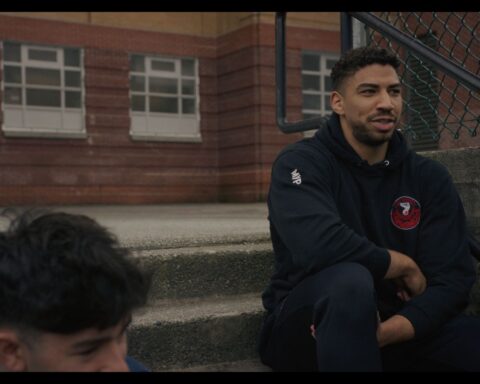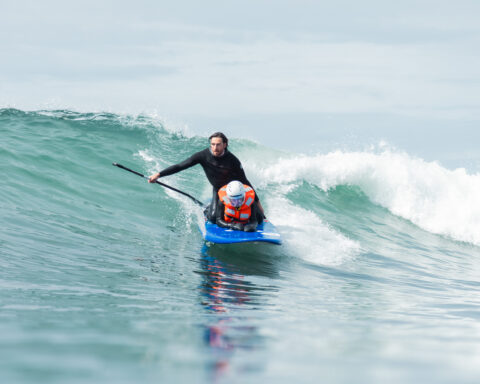Concordia University
Montreal, Quebec
Not resting on its laurels, The Mel Hoppenheim School of Cinema is looking ahead to keep pace with the industry. “We will not be throwing out Bolexes and Arriflexes,” declares the head of the film production programme, Roy Cross. “Realistically, however, we will transition to digital cameras starting next year. If the labs are processing and film stock is available, we will continue to keep our foot in the celluloid door.”
Post will also go digital with this year being the first that students won’t cut workprints on a Steenbeck. “We just completed construction and hardware-fitting of our new digital editing lab and classroom.”
In the first year, students write, direct and shoot two short films, one silent, the other a non-dialogue, wild-sound film. Second-year students branch out into documentary, fiction and experimental cinema. Depending on the professor’s approach, students pitch their ideas to a jury of professionals or graduate students in order to access resources such as cameras and other production equipment. Those not selected continue working on each other’s projects as cinematographers, art directors, editors, sound designers and various crew positions.
In the third year, students specialize in either fiction or experimental documentary (personal, interactive, “diary”). Students complete their docs, while fiction students pitch their projects to a jury of professionals and film graduate students. Five or six are chosen and given equipment, some funding, lab services and post-production facilities. Fifteen to 20 classmates crew these films. “By third year, some students have decided that they want to be cinematographers or editors,” notes Cross, The narratives run 15 to 25 minutes and are currently shot on 35mm, though postproduction is digital. Autodesk sponsors the postproduction with online and colour correction software. Technicolor also kicks in transfers to HD, and ACTRA performers appear in films without cost.
This year, seniors can also take two classes that look specifically at the evolution of cinema. “The Expanded Cinema class questions single-channel cinema production and broadens the definition of cinema to include multichannel and interactive models,” explains Cross. “The other course explores the boundaries of a six-lens camera and its subsequent exhibition in the Satosphere, the world’s first 360-degree domed cinema.”
Getting into Concordia isn’t easy, with nearly 10 hopefuls applying per spot. However, most classes are held to 16 so teachers can lavish more attention on each pupil. Many instructors are filmmakers themselves, including documentarians Daniel Cross of EyeSteel Films (Last Train Home, and no relation to Roy), Martin Duckworth, and Mary Ellen Davis. Tuition, at $2,885, is a bargain for Quebec students, but twice as much for other Canadians. A private campus apartment runs $4,000 to $5,400 per school year, though apartments near a Metro station are cheaper if students share one. Add to that the costs of making films in second and third years. However, Montreal has a rich cinema culture, home to several major film festivals like Festival du Nouveau Cinema and the Rencontres Internationales du Documentaire de Montréal.
New Brunswick Community College, Miramichi Campus
Miramichi, New Brunswick
Since the first class graduated in 1998, the New Brunswick Community College (NBCC) Miramichi Campus, has been offering a two-year diploma in Animation and Graphics. However, most of each year’s 20 new students are chosen from NBCC’s Art Fundamentals one-year programme, whose purpose is to build an applicant’s animation portfolio. “It’s not guaranteed they’ll be accepted,” warns instructor Tara Audibert, “but for the most part if they’re graduating from Art Fundamentals, they’re going to have the skills that we need. It’s very rare we would reject someone.” Art Fundamentals courses include drawing, storyboarding and digital imaging. Only two or three of the 60 applicants each year leaps directly out of high school.
The two-year Animation programme itself covers all aspects of production including scriptwriting, layout, acting, pre-production and sound editing.
Year two focuses on creating short films to enhance students’ demo reels. “Students usually have three works in progress and we get them to complete at least one,” says Audibert. Because animation takes so long to finish, teachers keep films under a minute while the unfinished films will be used to demonstrate a student’s skills. “We want to show that they can tell and storyboard a story,” explains Audibert, “but not necessarily animate all of it.” She adds that unlike fictional and documentary filmmaking, animation students work alone and not in crews.
While other animation schools focus exclusively on digital, NBCC still offers traditional paper animation to instill the basic principles of the medium.
NBCC also teaches 3-D animation in both years, specifically Autodesk 3ds Max and Mudbox software. Students study in a mock studio environment at individual workstations. They have at their disposal dedicated PC and Mac computer labs as well as professional-grade rooms to conduct sound recording, video editing and life drawing.
The NFB plays a vital role at NBCC. Students enjoy free use of the NFB Film Library, and every Friday students gather to critique animated NFB films. Says Audibert, “They ask questions like, ‘How was this film made? What works? How can we use what we saw in our own films?’”
NBCC is a small school, occupying two buildings. The benefit is intimacy: the seven instructors who hail from studios such as Disney and Nelvana can lavish more feedback on students than in larger institutions. Audibert herself is an NBCC grad and teaches layout, storyboarding, and Flash animation. She’s worked at places like Warner Bros. and on the Gemini-winner Olliver’s Adventures.
“We’re in a small corner of Canada,” says Audibert, “so it’s really good for [students] to travel to meet industry.” To do this, NBCC partially subsidizes the transportation of second- year students to the renowned Ottawa International Animation Festival. NBCC encourages its students to submit to the local Jalloo Festival of Animation and Games so that prospective employers can see their work. Some NBCC grads have landed jobs at DreamWorks, Sony, WB, Disney and CafeFX.
NBCC is a complete contrast to big-city universities such as Montreal’s Concordia. Thanks to provincial subsidies, tuition is only $3,000 a year (plus $2,000 in supplies and textbooks). There is no campus housing, so students live among the 18,000 townies in Miramichi, a friendly place where the parking is free and rent costs only $350 to $550 a month.
Nova Scotia College of Art & Design (NSCAD)
Halifax, Nova Scotia
Nova Scotia College of Art & Design’s (NSCAD)’s film programme is enjoying a muted 10th anniversary. Unlike other schools in eastern Canada, the film department is interwoven with the larger university. Every NSCAD student must take the Foundation Studies programme in their first year, which teaches the basics of various arts, from photography to video, and computer to wood and metal. In the second year, students take courses in general studio, art history, the liberal arts as well as introductory filmmaking and video. Only then can students declare their film major.
The final two years are pure film. “We start by shooting 16mm film, then move through the spectrum to hi-def video and the RED camera,” explains screenwriting instructor and chair of the school, Sam Fisher. Students can shoot in a 2,500 sq.ft. studio, but before they pick up a camera, they must build sets in the first term of year three. The second term sees them filming on location, either a drama or a doc. In year four, students create their thesis film and can take advantage of a Nova Scotia Film scholarship worth $12,000, which can benefit up to six films.
Fisher notes that NSCAD keeps pace with current industry technology such as Movie Magic to create call sheets, Adobe Creative Suite to support footage shot on their RED camera, and pretty soon will install a fullmotion-capture suite in one of the studios. The two full-time and four part-time teachers closely supervise pre-production to the point of videotaping workshops of complex scenes. “We make sure that the students line up their ducks in a row before we sign off and let them go to camera,” explains Fisher. “But we keep out of their hair on actual shooting days. We find that they get nervous and lean on you too much. Letting them make their own mistakes is important.”
In post, senior students mix in 5.11, while films completed by both third- and fourth-year students are exported to DCP (Digital Cinema Package) and screened at the end of each term at a local Cineplex. “Their last lesson is at the screening. They learn more here than the rest of the year, because now they see it,” comments Fisher. Many students also submit their work to the Atlantic Film Festival, which coincides with the start of the school year in Halifax.
Fisher boasts that more than half of graduates go on to work in the industry. Their instructors work in the business, notably Solomon Nagler, whose first feature, Gravity and Grace, recently screened at the Atlantic Film Festival. Recent alumni include Christian Sparkes, who launched his career at last year’s TIFF with the short A River in the Woods. The 50 or so NSCAD students who major in film pay over $3,400 per semester in tuition and fees, plus textbooks and filmmaking costs.
College of the North Atlantic: Media Arts Centre
Stephenville, Newfoundland
Farthest east in our survey is this handson production school. College of the North Atlantic: Media Arts Centre (CNA) awards students with a diploma after two years of studying film and video. “We teach a lot of the technicals for crews,” says one of the two instructors, Peter Buckle, “like lighting, grip, digital video and AVID editing with Media Composer 6 suites freshly upgraded. We don’t have courses designed around them, but we touch on wardrobe, props and set dressing.” There are also courses in screenwriting and business management.
Students produce short films by the end of the first year and continue with more in the second. In all, they will complete three or four shorts by enlisting their classmates as crew. “We want our students to get as much experience working on a set as possible,” says Buckle. Teachers supervise students in pre-production, overseeing storyboards and shot lists, but won’t go on set unless invited. “We generally leave them alone. We monitor students by having each crew member write a report on set about what they learned, what problems there were, and so forth.”
Equal time is awarded to documentaries, with students expected to complete one fictional film and one doc per year. That partially explains why CNA students shoot on video, not film. The first-year class shoots mini-DV with the Canon XL-2 and XLH-1, while the second year films are on the Panasonic HVX200. Students cut on Avid and can receive an Avid certificate after passing a test. “Teachers sit down to talk about the students’ assembly cuts to fine-tune them,” says Buckle. The second-year finished films are publicly screened and CNA also hosts a 24-hour film festival.
Students complete their first year with three, not two semesters. “Our first two are filled with general courses, then the third is an intersession,” explains Buckle. “So we have five semesters in our programme.” To compensate for the shortage of professional film shoots in this town of 6,700, the intercession offers students on-the-job training. “Students create a film from scratch. They pitch ideas to the class which we discuss, then choose one and develop that into a script.” Students are assigned crew roles, though a professional director is hired to helm a 15-minute film that is publicly screened and hopefully sold to a broadcaster.
Classes are small: 12 in the first year, 10 in the second, based on 20 applications. Tuition is only $726 per semester, plus $343 for the seven-week intersession. Buckle, a Newfoundland filmmaker, is one of only two instructors.











